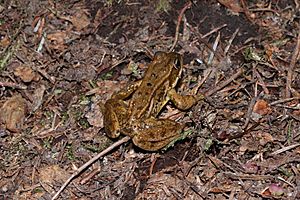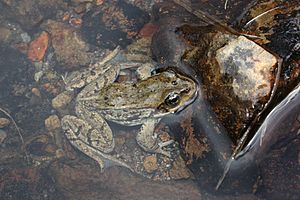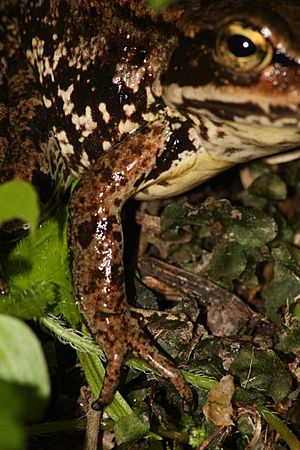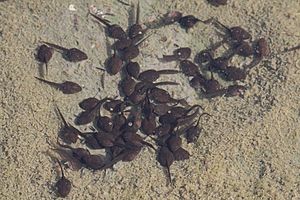Cascades frog facts for kids
Quick facts for kids Cascades frog |
|
|---|---|
 |
|
| Mount Pilchuck State Park | |
| Conservation status | |
| Scientific classification |
The Cascades frog (Rana cascadae) is a type of frog that lives in the Pacific Northwest region of North America. You can mostly find these frogs in the Cascade Range and Olympic Mountains. They belong to a group of frogs called true frogs.
Contents
About the Cascades Frog
What Does It Look Like?
The Cascades frog has a green to brown color on its back. Its throat and belly are a light yellow. It usually has a few to about 50 gray spots on its back. These spots can change color from light gray or brown to a darker black.
The colors on the frog's back also help it attract mates. The frog's head is usually oval-shaped. Its mouth comes out to a slight point. Adult frogs are about 50 to 65 millimeters (2 to 2.5 inches) long.
What Does It Sound Like?
The Cascades frog makes a quiet call to attract other frogs. It sounds like a low, grating, clucking noise. These calls can be heard both at night and during the day. Frogs call from above and under the water.
Where Do Cascades Frogs Live?
The Cascades frog was first found in the Cascade Mountains in California. Today, you can find them throughout the Cascade Mountains. Their range goes from Washington through Oregon and into California. They are often found near volcanic areas of the mountain peaks.
Their natural homes are temperate forests and temperate grassland. They also live near rivers, swamps, and freshwater lakes. You can find them in temporary freshwater lakes and freshwater marshes. These areas are usually between 665 and 2,450 meters (2,180 to 8,040 feet) high. In Washington, they might live at lower elevations.
They can be found in small, permanent, and temporary ponds. They also live along streams in the summer. Adult frogs usually stay close to water. They like sunny shores, especially when it's dry in summer. But they can travel across dry land when it's humid.
How Do Cascades Frogs Behave?
How They Reproduce
Cascades frogs lay their eggs between May 20 and July 10. This depends on when the snow melts and creates ponds. They lay their eggs in warm, shallow water. These spots are often protected from strong waves.
A female frog can only lay eggs once a year. It is not known if they skip years. One female can lay up to 425 eggs at a time. However, only a few tadpoles will survive past their first year. Egg masses laid in shallow water right after the snow melts can freeze. Diseases can also spread between egg clusters.
The eggs hatch in about 8 to 20 days. The tadpoles live for 80 to 95 days. Most frogs grow to their full size after three years. Then, they can start mating. Adult frogs seem to use the same places to breed for several years.
What Do They Eat?
Young Cascades frogs (larvae) are thought to eat mostly things found on the bottom of ponds. But what they prefer to eat is not well known. We also don't know much about what adult Cascades frogs eat. However, they are thought to eat many different small animals without backbones. Sometimes, they will even eat other frogs and tadpoles.
Cascades Frog Population

Female Cascades frogs tend to die younger than males. But both are believed to live for more than five years. Some can even live up to seven years.
Recently, the number of Cascades frogs has gone down. But this decline is not too serious. It mostly happens in the southern parts of where these frogs live. We don't fully know why this is happening. But some ideas include new predators like trout and bullfrogs. Too much UV-B radiation from the sun, diseases, and losing open meadow habitats are also possible reasons. Fertilizers like urea might also harm Cascades frogs. Young frogs could not sense or avoid dangerous levels of urea in lab tests.
Who Are Their Predators?
The main animals that hunt Cascades frogs are raccoons, minks, and coyotes. Large water bugs, garter snakes, and several bird species also hunt them. These birds include sharp shinned hawks, owls, Canada jays, and American robins. Long-toed salamanders and adult Cascades frogs also eat the eggs and tadpoles.
Frog Defenses and Science
To protect themselves from tiny living things in their environment, Cascades frogs make special chemicals. These are called antimicrobial peptides. They release these chemicals from their skin when they get an infection or are stressed.
Scientists have found that frogs in the Rana group, like the Cascades frog, are a good source of these peptides. These chemicals can fight against many different tiny living things. One scientist, J. Michael Conlon, tested these frog chemicals. He wanted to see if they could affect bacteria that attack human cells.
He found a chemical called ranatuerin-2CSa. This chemical, made by the Cascades frog, stopped the growth of E. coli and S. aureus in humans. These chemicals that fight infection could be helpful for future medicines.
However, the ranatuerin-2CSa peptide from the Cascades frog has a drawback. It can thin human blood and reduce oxygen in the bloodstream. Scientists found a way to make it safer. They added amino acids to the peptides. This created a new chemical called D-lysine. This new chemical is like ranatuerin-2CSa but is much less harmful to human cells. Since it thins blood much less, it is almost harmless to humans.
Images for kids
See also
 In Spanish: Rana cascadae para niños
In Spanish: Rana cascadae para niños





